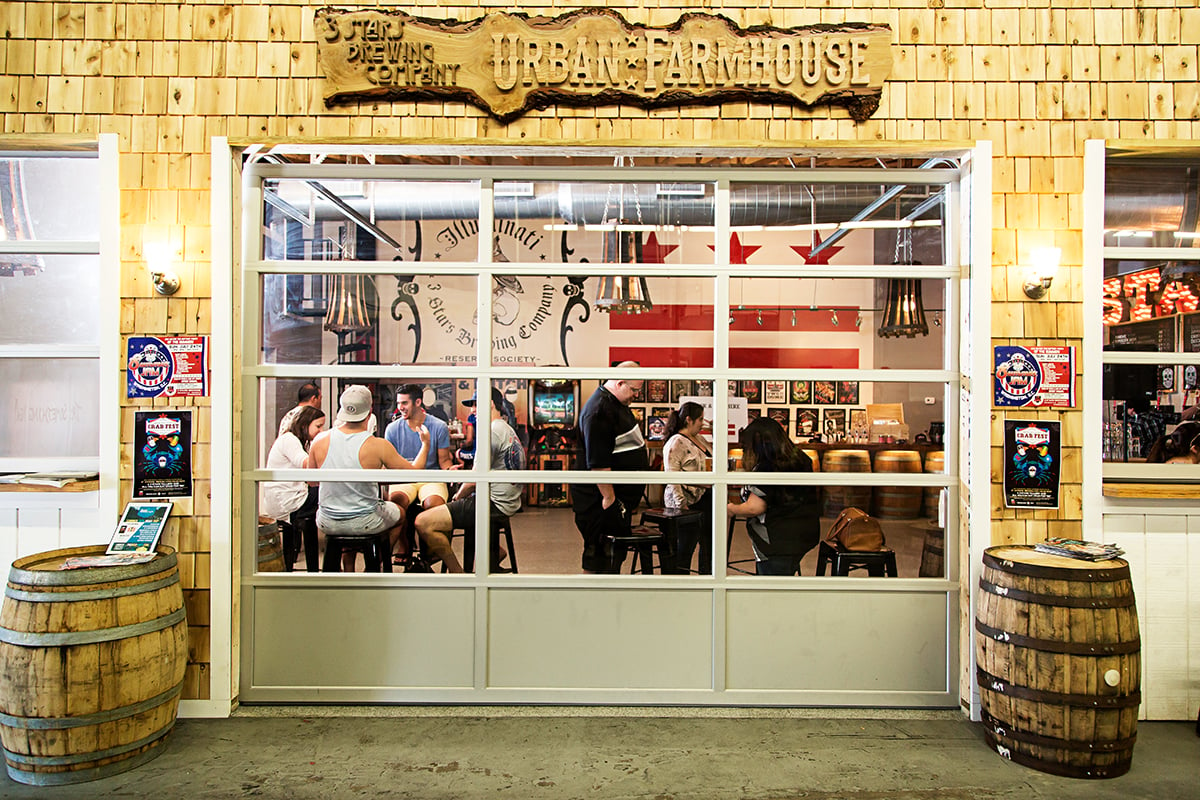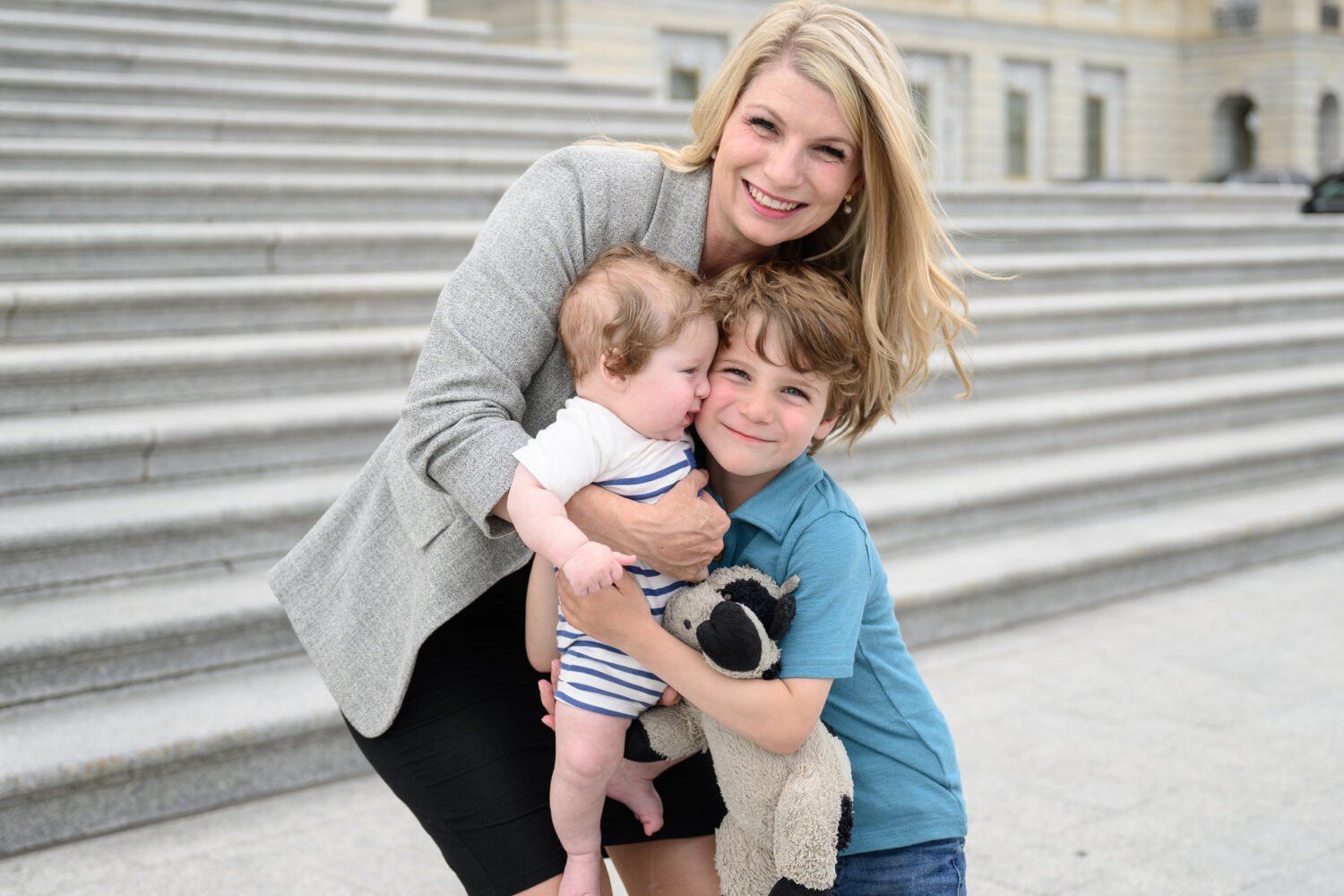On an October weekend so warm that Snow Queens and Tchaikovsky scores seem faraway notions, more than 200 students of the Washington School of Ballet pour into the school and company studios on Wisconsin Avenue to audition for this year’s Nutcracker.
Ballet moms and dads wait in the lobby, filling the place with big dreams and high anxiety, pinning audition numbers on the pink leotards of eight-year-olds hoping to be a soldier, a party girl, a mushroom—anything.
In one of the school’s five studios, Washington Ballet artistic director Septime Webre leads a group of boys in black tights and white T’s through a lively combination to be danced by rats in the production. “The rats have very serious technique,” the floppy-haired director says as he demonstrates a big jeté with clawed hands.
The boys will all have some part in the production, Webre tells them, and will need to show up next Saturday at 3:30 for the first rehearsal.
A small hand flies up. “I have a soccer game next Saturday.”
Such are the challenges of mobilizing a cast of 300, most of them in second and third grades.
Next to come through the studio are ten nervous teenage girls auditioning for the part of Clara, the holy grail of roles for girls, and three small boys who’d been called back for the role of her mischievous little brother, Fritz.
Gabriel Hearn-Desautels, a nine-year-old with a mop of blond hair and a ballet bag slung over his shoulder, is praying he’ll be chosen as Fritz. Last year he was the understudy.
Of course, last year there were bigger disappointments.
It was the year of what the staff calls “the interruption,” the year when the Washington Ballet became the dance company that stole Christmas, the year when relatives who’d flown in from Venezuela, Romania, all over the world to see family members dance on the stage of the Warner Theatre never got the chance.
“I cried for 15 minutes straight,” Gabriel says, recalling last year’s abrupt cancellation of the Washington Ballet’s Nutcracker over a labor dispute between the 20 dancers of the professional company and management.
Kay Kendall, president of the Washington Ballet’s board, knew how devastating a blow it was—on every level. In the 1980s, her own daughter and son had been cast as Clara and Fritz in the company’s production, so she knew what a thrill the show could be for the kids and their families.
The 30-year-old company had become such a beloved part of the Washington arts landscape that all last winter, as the ballet canceled performance after performance, friends called to say, “Kay, if you don’t resolve this, you’re going to have to leave town.”
As the company’s dancers picketed in front of the theater where they would have been dancing, donors crossed the Washington Ballet off their giving list.
“It was like the whole world stopped,” says Kendall. “It was like Sleeping Beauty’s castle.”
A year later, as the ballet approaches what all assume will be a full run of The Nutcracker, a local tradition for nearly half a century, everyone is working to put behind them what executive director Jason Palmquist calls “our difficult time.” They are trying to heal the wounds of a year made even more painful by the deaths of the ballet school’s director, Rebecca Wright, and the company’s revered founder, Mary Day. Most of all, they’re trying to get beyond the hurt feelings and mistrust between dancers and management—including Webre—and repair the reputation of a company that, with the national spotlight on them, came close to collapsing.
“It was extremely painful to go through,” says board member Dorothy Pierce McSweeny of the conflict.
The labor dispute was not primarily about money. It was about, from the dancers’ point of view, respect; from management’s viewpoint, artistic control. And after a winterlong impasse in which dancers were out of work and the company lost nearly $1.5 million, the conflict ended in March with a first-ever union contract—and emotions as frayed as worn-out pointe shoes.
The mending started soon after with performances of new works before full houses and standing ovations in May and, a month later, the company’s most successful fundraiser ever.
“I was nervous about going back to work,” says Webre, “but the city seems excited to have us back.”
Getting his Nutcracker back on stage this December will be another key step for the company, both symbolically and financially.
Kendall recently walked through the warehouse where all the nutcrackers, dolls, and wands—souvenirs that little girls in velvet dresses were to have bought at last year’s performances—sat collecting dust. No one got to see them. This year, balletgoers will.
Webre is in the studio one rainy fall day, doing what he loves most—creating a new work for the company. Dressed in a white long-sleeve T-shirt, black Adidas workout pants unzipped at the ankles, and black-and-white sneakers, he darts around the floor, showing dancers the “Janet Jackson ripple” he’s after or the “deeper level of musicality” he wants to punctuate the French cabaret songs that accompany his new work, Oui/Non.
“You need to get to the arabesque by the fourth measure,” Webre tells the dancers. But there’s not enough time, they say. It isn’t working. He finesses the choreography. The eight-part piece, which would premiere at the Kennedy Center in October, is a demanding work, full of lifts, throws, and tricky acrobatic maneuvers like the one he calls the “human rotisserie.” But that’s Webre’s style: energetic, athletic, flashy.
At 12:55, Webre looks at the clock. “Y’know what? Let that incubate,” he tells the dancers, knowing that every 55 minutes, whether he’s ready or not, there will now be a union-mandated five-minute break.
Much of the conflict of the past year centered on the 44-year-old choreographer, the seventh son among nine children—thus the name Septime—born to a Cuban mother and French-American father.
In his seven seasons here, Webre has been a charismatic and visible leader. He is credited with transforming Day’s well-regarded but staid neoclassical ensemble into an adventurous company with a maverick flair and with raising the ballet’s profile. “When I used to say I was with the Washington Ballet, people thought I was visiting from Seattle,” says dancer Chip Coleman, who’s been with the company for 13 years.
Now the company, considered one of the nation’s top midsize ballets, is performing large-scale works and sophisticated pieces, such as Twyla Tharp’s In the Upper Room, that it couldn’t have handled years ago.
“The direction of the company is so forward,” says Dance Magazine editor Wendy Perron.
Webre also is making the Washington Ballet a real presence throughout the community.
He started Dance DC, a program to offer free ballet classes to kids in a handful of DC public schools. And last year the ballet began offering classes, most of them through full or partial scholarships, at the Town Hall Education, Arts, and Recreation Campus (THEARC), a new $26.5-million arts-and-education center in DC’s Anacostia, where the company previews works before official openings at the Kennedy Center and other venues.
This year, the company’s Nutcracker will premiere at THEARC, with five performances featuring 50 of the kids who take classes there.
Virginia Johnson, a Mary Day protégé who went on to become a principal with Dance Theatre of Harlem, applauds Webre’s success in connecting the company to Washington through outreach and also in creating diverse and theatrical programming. “What Septime is doing is popularizing his program, making it more accessible to people who might not have a big background in classic culture,” says Johnson, now editor of Pointe, a ballet magazine. “He’s building a bridge, showing people what ballet can be without throwing away what ballet is.”
At ease in front of an audience, Webre often sprints onstage at the company’s performances, introducing the works and holding ten-minute Ballet Talks afterward, in which he takes questions. He’s brought children from the audience up to the stage before performances to show them how he creates a ballet. “My goal is to humanize and demystify what we do,” he says, adding that his Latino heritage makes him a natural host: “Welcome to my home—mi casa es su casa.”
The gregarious artistic director is also happy stepping outside his casa and into Washington’s social scene, often hitting the dance floor at fundraisers with Kendall. He charms the ladies in hats on the ballet’s women’s committee, board members, and donors alike.
The ballet’s $7-million budget is more than double what it was when he arrived in 1999. The subscriber base is more than three times larger.
But inside the studio, where dancer and choreographer forge a bond that is intimate, physical, and fragile, there had been tension.
Before joining the American Guild of Musical Artists last year, dancers had complained that Webre’s rigorous works and intense rehearsal schedule had led to injuries and that the schedule would be posted, changed, or canceled with little or no notice. They worried about job security after two company members who’d been active in unionizing the ballet were let go by Webre, although he insists there was no connection.
Webre now says he wishes he’d been less “tone deaf” to the dancers’ concerns and regrets that he was not more supportive of their decision to unionize—a decision that defied the wishes of the board, which believed it could handle any issues that came up within the small, familylike company.
Now, Webre says, he is “probably being a little more mindful of not overworking” his company and has a renewed appreciation and respect for the dancers. “By the dancers standing up and saying, ‘We’re grownups, treat us like grownups,’ which is what they did, it demanded my attention. It raised my level of respect for them.”
The new, 65-page contract, which covers the dancers through the end of the 2007–08 season, guaranteed that all dancers would be kept on for this season and that at least 80 percent of the company would be rehired for next season. Webre says the contract reflects the industry standard in terms of job security for the dancers and gives the artistic director freedom to determine membership of the company from year to year.
After the contract was signed in March, federal mediators led dancers and management in six hours of group therapy. The ballet expanded its health-and-wellness program for dancers and established a joint committee of dancers and staff that meets monthly. “Minding the healing process,” says executive director Palmquist, “is a priority shared by both management and the dancers.”
But it’s not been as simple as picking up where they left off.
“In some respects, we’re a new company,” says dancer Luis Torres. “We’re still the same dancers, but people change during hard times, and a lot of us changed. Once we’re in the studio dancing, we’re not thinking about what happened a year ago. We’re thinking about the steps and trying to do our best. The healing of the wounds will happen because of that.
“But it’s a process. We had a big wound and now we’re treating it. It takes time to heal. Some people still have some hard feelings.”
Several dancers, who asked not to be named, say they’re disappointed that improvements haven’t been quicker in coming. There has been some commotion this season: When Webre changed a rehearsal time without giving the dancers as much notice as the new contract requires, the dancers sat out the rehearsal. In October, dancers and staff clashed over whether chemicals used to create a fog effect during Tharp’s 39-minute ballet were safe for dancers to breathe. The day before the season-opener, four dancers were cut from a ballet.
“They may be sticking to the terms of the contract,” one dancer said of the artistic staff, “but they’re not living up to the spirit of it.”
Eleni Kallas, the local union representative for the dancers, says: “We’re experiencing a lot of growing pains. We know we’re going to have to work very hard together in order to make it a better place.”
Palmquist says he believes the artistic staff has shown “a real sensitivity” to the health and welfare of the dancers since the contract dispute but adds, “It’s obviously a delicate balance.”
Finding that balance may continue to be a challenge as Webre launches what he says is a three-to-five-year plan for “taking the company to the next artistic level and the next level of national prominence.” For the 19 professional dancers, that means tackling more-difficult repertory as the company competes for the region’s balletgoing audience with the world-class touring companies that frequent Washington’s stages. “Certainly the bar is set very high in Washington,” says Palmquist.
Mary Day, whose larger-than-life portrait looks over the Washington Ballet’s lobby, was a legend in the ballet world. The school she started in her home in 1944 produced ballet stars by the dozen, including Kevin McKenzie, now artistic director of American Ballet Theatre; former ABT principal Amanda McKerrow; and Virginia Johnson. The three were among those honoring the longtime teacher at a recent tribute to her at the Kennedy Center.
Day retired as artistic director of the company in 1999, handing the reins to Webre. His is a more ambitious and less conventional troupe than Day had envisioned—and it was no secret that Day was unhappy with the direction in which Webre was moving. In March, months before she died at age 96, she told the Washington Post that the grander scope of the company was “entirely different than I planned.”
But Webre, a self-described “club kid” who didn’t start ballet training until a student at the University of Texas, says he’s committed to the founder’s vision of a well-trained company exploring neoclassical work. And Day’s enduring presence—Studio 1 had once been her living room, and Webre’s office was her bedroom—is always there as a reminder.
“It’s like having a message from your mother reminding you to behave well while you’re off at college and tempted not to behave well,” says Webre, showing off an old butterfly-print shower curtain that still hangs in the bathroom in his office.
There’s a certain warmth in seeing fragments of Mary Day’s life peek through the studios and offices of the Washington Ballet. But with a school of about 425 students—as well as the company—the ballet’s home is bursting at the seams and not aging as gracefully as its founder did.
“Studio 1 is where Shirley MacLaine took classes,” says Kendall. “And I don’t think it’s changed much since then.”
The cancellations of the past year left the Ballet $850,000 short in its operating budget for the year, forcing the company to dig into funds that had been reserved for upgrades to the company’s home.
Kendall thinks the ballet needs two or three more studios and an overhaul of basic plumbing and wiring, some of which dates to 1915. The work could cost $15 million to $20 million.
The board president, a full-time volunteer, says she’s thinking of new fundraising ideas—maybe a “Dancing With the Stars” gala, enlisting Washington celebrities.
For now, she and Webre and the board are focused on getting momentum back, a challenge made greater still by the departure this summer of audience favorite Michele Jimenez, who has gone to the Dutch National Ballet. Webre has started inviting subscribers and donors to the studio to watch midday rehearsals. He’s stepped up other “cultivation events” such as Beer and Ballet evenings (open rehearsals followed by a microbrew tasting, aimed at the 25-to-45 set) and special rehearsal viewings for diplomatic spouses and for students.
This season’s program, which includes several major master works—the Twyla Tharp piece and ballets by Paul Taylor and Christopher Wheeldon—was designed to “pack as big a punch artistically as possible,” says Palmquist.
And then there is The Nutcracker. The company hopes that audiences who may have gone Nutcracker-less last winter—or turned to rivals—will return to its distinctive version.
So far, the outlook is bright. Webre, who admits to an eye for irony and the artistic curveball, believes there may be some truth to the saying that there’s no such thing as bad publicity. “In a slightly counterintuitive way,” he says, “all the publicity has led to an increased awareness of our work.”
The renewal rate for season-ticket holders is higher than ever. Donors have returned to the fray. Ticket sales for The Nutcracker, which will feature local personalities like power broker Vernon Jordan and ABC’s George Stephanopoulos in cameos, have been “going gangbusters,” says Palmquist. Nine-year-old Gabriel will this year get to play Fritz.
The static between the dancers and their employers has not vanished. But to the credit of all, it has not shown up in performances, which, since the end of the dispute, have won praise from critics.
The stage, says Washington Ballet dancer Runqiao Du, has been “great medicine” for the company as it regains its footing.















